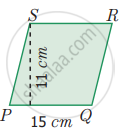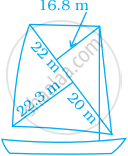Advertisements
Advertisements
प्रश्न
Find the missing value.
| Diagonal (d1) | Diagonal (d2) | Area |
| 26 m | 468 sq.m |
उत्तर
Given diagonal d1 = 26 m
Area of the rhombus = 468 sq.m
`1/2` (d1 × d2) = 468
`1/2` (26 × d2) = 468
(26 × d2) = 468 × 2
d2 = `(468 xx 2)/26`
d2 = 36 m
Tabulating the results we have
| Diagonal (d1) | Diagonal (d2) | Area |
| 26 m | 36 m | 468 sq.m |
APPEARS IN
संबंधित प्रश्न
Lengths of the diagonals of a rhombus are 15 cm and 24 cm, find its area.
If perimeter of a rhombus is 100 cm and length of one diagonal is 48 cm, what is the area of the quadrilateral?
If length of a diagonal of a rhombus is 30 cm and its area is 240 sq cm, find its perimeter.
Each side of a rhombus is 18 cm. If the distance between two parallel sides is 12 cm, find its area.
A thin metal iron-sheet is rhombus in shape, with each side 10 m. If one of its diagonals is 16 m, find the cost of painting both sides at the rate of ₹ 6 per m2. Also, find the distance between the opposite sides of this rhombus.
Find the area of rhombus PQRS shown in the following figure.
Find the missing value.
| Diagonal (d1) | Diagonal (d2) | Area |
| 12 mm | 180 sq.mm |
The angle between the diagonals of a rhombus is
A man has to build a rhombus shaped swimming pool. One of the diagonal is 13 m and the other is twice the first one. Then find the area of the swimming pool and also find the cost of cementing the floor at the rate of ₹ 15 per sq.cm
Most of the sailboats have two sails, the jib and the mainsail. Assume that the sails are triangles. Find the total area sail of the sailboats to the nearest tenth.

